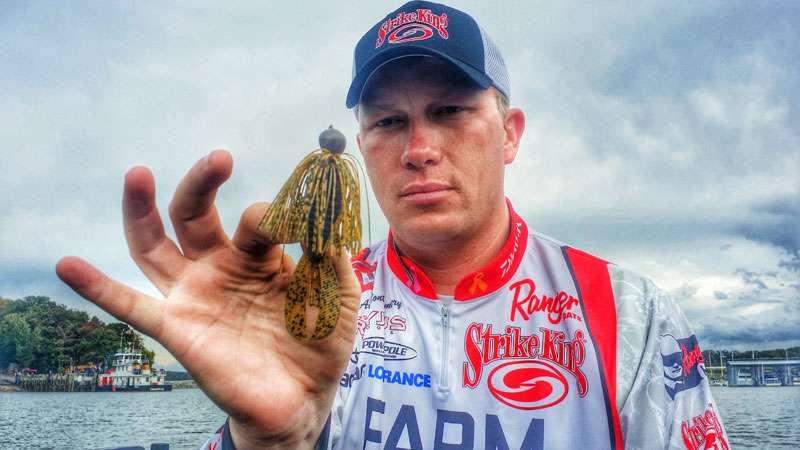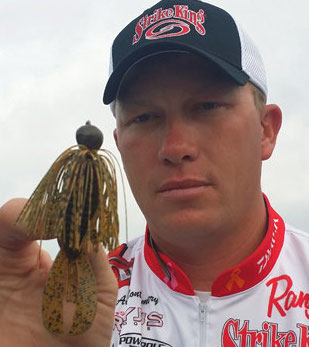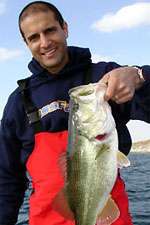
One of Andy Montgomery’s home lakes is Norman, so he definitely knew what to expect going into last weekend’s Southern Open. Then again, anyone whose ever heard anything about Norman knows it’s no secret where the bass are: docks.
In those kinds of tournaments, it’s always the subtle things that separate the winners from the rest of the field, and that was the case in Montgomery’s win. Here’s how he figured it out.
Practice: Only looking
In practice, he only fished “a little bit. I was just doing a lot of riding around, trying to gather my thoughts,” he said – he hadn’t been there in a while. “I’ve fished the lake a lot, and once I rode around and visually saw stuff, a lot of it came back to me.”
When he fished in practice, it was on “regular” docks, meaning not his best stuff. “Certain docks are always better,” he noted.
His practice ended up mostly being a confirmation of his game plan and bait choice, which probably were the exact same for almost all other competitors: fish docks with a jig.
Tournament: Moving shallower
Day one was foggy in the morning, so he picked up a topwater and caught a limit. When the sun shone through at about 10:00, he picked up the jig and ended up culling all the topwater fish flipping docks with brushpiles.
“One of the keys on Norman is getting a 3-pound-plus bite,” Montgomery said, and “I knew you’d probably need close to 13 pounds a day to win. That day I caught two in the 3.5-pound class, and that got me to 13 pounds.” He went through 40 fish to get there.
Day two was windy and cloudy, and it started raining heavily around 1:00. “When conditions are like that, the fish have a tendency to suspend over the brush or roam around,” he said. Because of that, he moved shallower. “The shallower fish are easier to catch – it’s a whole lot easier to catch fish in 2-3 feet vs. suspended in 15-20 – and also some of the [brush] fish may have moved shallow,” he said.
Late on day two he got on a pattern fishing the walkways between docks, and that ended up being key for him on the last day.
Day three was sunny with blue skies, so Montgomery anticipated the fish would be back on the brushpiles. He fished that way and caught a smaller limit, then went down a stretch of docks and decided to check the walkway pattern. Sure enough they were there, and it was game on the rest of the day. He didn’t catch a lot of fish (about a dozen, same as day two), but they were better ones.
Subtleties were key
On Norman, you have to fish docks. That means 145 anglers were banging docks for two solid days, which means you’re always fishing behind someone. Last weekend that was particularly true at the lower end of the lake because that’s where most of the field was.
“Mid-lake and the upper lake had turned over, and that definitely scared some people,” Montgomery said. Not him, though: “I fished there every day, and also some stuff on the lower end.”
He also hit about 50 docks a day. “Every day I repeated some stuff and mixed in some new stuff hadn’t previously fished,” he said.
His best docks were on main creek or river channels, with the fronts of most docks in 6-8 feet.
Other competitors were fishing those docks too, but he was catching fish behind them because presentation was super important. “Bait placement is key there, and that’s my strength,” he said.
One example: “Where I caught almost a 4-pounder on day one, you had to [pitch a jig through] a 3-inch wide by 3-inch tall opening, and put it 20 feet back under the dock where the brushpile is.”
He knew almost no one could make that presentation. “My confidence on Norman is very high because I feel like I can put a bait places where a lot of fish won’t see a bait,” he said.
Winning bait
 He fished a local Shooter Lures jig, 1/2-ounce, in crawdad color with a Strike King Rage Bug (green pumpkin). The combination was ideal, he said, because the jig skips well and because spotted bass love the high-action tails of the Rage Bug.
He fished a local Shooter Lures jig, 1/2-ounce, in crawdad color with a Strike King Rage Bug (green pumpkin). The combination was ideal, he said, because the jig skips well and because spotted bass love the high-action tails of the Rage Bug.
He fished it with a 7-foot Daiwa Zillion rod (medium-heavy), a Daiwa Tatula 7.3:1 reel and 20-pound Seaguar InvizX fluorocarbon.

